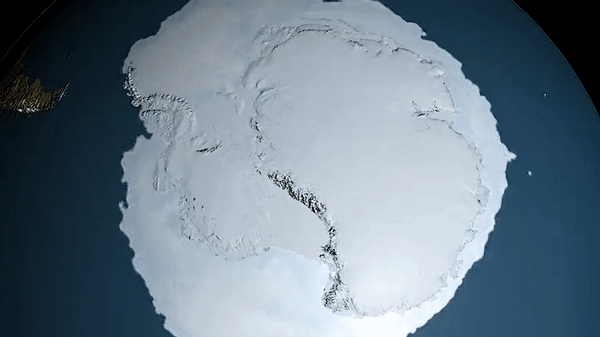Antarctic sea ice hits record low, satellites reveal

Antarctic sea ice shrunk to a record low in February this year. Satellite measurements revealed that only 66% of the sea ice extent usually detected during the peak of the southern summer has been present in the waters surrounding the South Pole last month.
The previous monthly record low was reported in 2017 out of a series of measurements that dates back to 1979, the European environment-monitoring agency Copernicus said in an emailed statement.
The agency's Sentinel satellites found below-average sea ice concentrations in all regions of the Southern Ocean, the southernmost part of the global ocean that surrounds Antarctica.
"Our latest data show that Antarctic sea ice reached its lowest extent in the 45-year satellite data record," Samantha Burgess, the Deputy Director of the Copernicus Climate Change Service, said in the statement. "These low sea ice conditions may have important implications for the stability of Antarctic ice shelves and ultimately for global sea level rise. Polar ice caps are a sensitive indicator of the climate crisis and it is important to closely monitor the changes occurring there."
Related: Doomsday Glacier melting in Antarctica means terrible news for global sea level rise
According to an earlier announcement by the U.S. National Snow & Ice Data Center, the amount of ice floating in the Antarctic seas dropped to 737,000 square miles (1.91 million square kilometers) on Feb. 13 this year, breaking a previous record for a lowest daily value reported on Feb. 25, 2022. At that time, however, the lowest extent was reached closer to the end of the melting season.
"In past years, the annual minimum has occurred between February 18 and March 3, so further decline is expected," the U.S. National Snow & Ice Data Center said in the statement issued on Feb. 14.
The amount of sea ice around Antarctica is usually at its highest in September when it peaks at about 7 million square miles (18 million square kilometers). The annual lows, usually reported in February, tend to hover at around the 772,200 square-mile (2 million square km) mark, according to The Guardian. This year, however, the amount of Antarctic sea ice dropped as low as 691,122 square miles (1.79 million square km) on Feb. 25, the Guardian reported.
Antarctica, traditionally more resilient to the effects of climate change than its smaller northern counterpart, the Arctic, has experienced strong winds during the southern spring that accelerated the ice loss, according to The Guardian.
Scientists are sounding alarm bells about the future of Antarctic sea ice, as the whole continent's ice sheets and glaciers hold so much water that they would cause a significant rise in global sea levels if they were to melt.
Related stories:
— Europe warming twice as fast as rest of the world, new report reveals
— Satellites show Arctic sea ice is melting even faster than scientists realized
— Over a third of Antarctic ice shelf could collapse as climate change warms the Earth
The Arctic, which has just passed the peak of this year's winter season, didn't fare well in February either. Satellite data revealed the second lowest February sea ice extent since satellite measurements began. With sea ice extent measuring 4% below the average for the month, the Arctic was only in a slightly better position than in the years 2016 and 2017, which jointly hold the record for the lowest Arctic sea ice extent during the peak winter period.
February 2023 was the fifth warmest February globally, with most of Europe warmer than usual, Copernicus said. The U.S. East, northern Russia, Pakistan and India also experienced above average temperatures. The U.S. West, northeastern Russia, Turkey and northern Australia, on the other hand, experienced a colder February this year.
Follow Tereza Pultarova on Twitter @TerezaPultarova. Follow us on Twitter @Spacedotcom and on Facebook.
